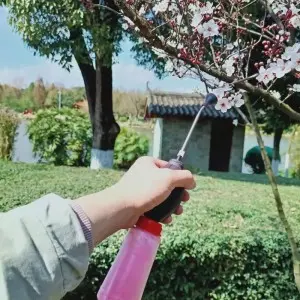okt . 15, 2025 09:31 Vissza a listához
Artificial Pollination: Boost Yields—Ready to Scale?
A field note on the lithium era of orchard pollination
I’ve walked more orchards than I’ve walked city blocks, and lately growers keep asking about artificial pollination that’s fast, predictable, and doesn’t fall apart when the weather turns moody. Enter the LITHIUM ELECTRIC POLLINATOR FOR ORCHARD—developed over five years, with an international utility-model patent in the bag, and built in Caozhuang Development Zone, Fanzhuang Town, Zhao County, Shijiazhuang, Hebei Province. Medium-sized blocks (about 10–20 mu; roughly 0.7–1.3 ha) are its sweet spot.

What’s driving the shift
Honeybee rentals cost more, weather windows are tighter, and fruit-set targets keep going up. To be honest, growers want control. With artificial pollination, you choose the hour, the mix, and the coverage—without betting on a perfect bloom week. Many customers say the biggest win is consistency, not just yield.
How it’s built and how it runs
The device pairs a lithium battery with a compact electric motor, a powder storage tank, and an extension rod—simple on purpose. Materials are a mix of ABS for the housing, stainless hardware where it counts, and sealed connectors for field reliability. Method-wise, you pre-condition pollen (sieved, moisture-balanced), load, then pulse-apply along the canopy at 20–40 cm from blossom clusters. We’ve seen crews calibrate by gram-per-minute, which is nerdy, but effective.
| Specification | LITHIUM ELECTRIC POLLINATOR (≈) |
|---|---|
| Battery | Li‑ion pack, 18–20 V, 4–6 Ah (UN 38.3 tested) |
| Motor | Brushless DC, ≈100–150 W |
| Powder tank | 0.5–1.0 kg capacity |
| Extension rod | Up to ≈2.0 m, detachable |
| Flow rate | ≈0.5–3 g/min adjustable |
| Runtime | ≈3–5 h per pack (real-world use may vary) |
| Ingress rating | IP54 equivalent |
| Certs | ISO 9001:2015 (factory), CE/RoHS (device) |
| Service life | Battery ≈500–800 cycles; chassis 3–5 seasons with maintenance |

Process, testing, and standards
- Materials and build: ABS housing, stainless fasteners, food-contact-safe powder path.
- Methods: sieve pollen (100–150 μm), keep moisture ≈6–8%, calibrate gram-per-row.
- Testing: battery transport to UN 38.3; EMC/CE checks; dust ingress per IP54; drop tests at 1 m.
- Quality: factory QA aligned to ISO 9001; batch traceability on motors and packs.
Where it shines
Apples, pears, kiwifruit, almonds—especially when bloom is compressed, bees are sluggish, or precision cross-pollen is required. Crew leads like the low noise and the “point-and-dust” control. It seems that artificial pollination is less a last resort now and more a core tool.
| Method/Vendor | Coverage (≈) | Precision | OpEx | Notes |
|---|---|---|---|---|
| LITHIUM ELECTRIC POLLINATOR | 0.5–1.0 ha/day | High, targeted | Low–medium | Best for 10–20 mu blocks |
| Manual brush teams | 0.1–0.3 ha/day | Very high, slow | High (labor) | Reliable but labor-heavy |
| Drone broadcast | 2–5 ha/day | Medium | Medium–high | Great scale; wind sensitive |

Customization and support
Options include nozzle apertures for different pollen grains, extended rods for high trellises, spare battery packs, and branded kits. Service life hinges on clean, dry pollen and routine seal checks—simple stuff, but it pays.
Field notes and outcomes
Hebei apple block (12 mu): crew reported 8–12% higher fruit set versus bee-only rows; pass time dropped by ~30%. Shaanxi kiwifruit (18 mu): tighter size distribution, fewer blanks; manager said, “Finally, timing is ours.” Sure, every season is different, but the pattern is consistent.
Standards and references
Testing references include UN 38.3 for lithium transport, CE/EMC conformity for electronics, ISO 9001 for factory QA, and IP54-style dust/water resistance checks. For context on pollination economics and yield elasticity, see below.
- FAO. Pollination of Crops. https://www.fao.org/pollination
- IPBES. The Assessment Report on Pollinators, Pollination and Food Production. https://ipbes.net
- UN Manual of Tests and Criteria, Part III, Sub‑section 38.3 (UN 38.3). https://unece.org
- ISO 9001:2015 – Quality management systems. https://www.iso.org/standard/62085.html
- European Commission – CE marking and EMC Directive. https://single-market-economy.ec.europa.eu
-
Apple Tree Pollen for Sale – Fresh, High Viability, Fast
hírekNov.20,2025
-
CE Certification Netting Bags for Fruit Trees: Durable & Reliable
hírekNov.20,2025
-
Premium Pear Tree Pollen — High Viability for Bigger Yields
hírekNov.20,2025
-
Functions and Applications of Fruit Protection Bags
hírekNov.20,2025
-
kiwipollen: Premium Kiwi Pollen, High Viability & Cold-Chain
hírekNov.20,2025
-
Apple Tree Pollen for Sale – Fresh, Pure, Fast Shipping
hírekNov.20,2025